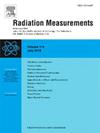平面CdZnTe热中子探测器的性能
IF 2.2
3区 物理与天体物理
Q2 NUCLEAR SCIENCE & TECHNOLOGY
引用次数: 0
摘要
核素113Cd对热中子很敏感。113Cd(n,γ)114Cd反应产生的伽马射线能量大多为558 keV。CdZnTe探测器含有Cd-113。它们对伽马射线的良好能量分辨率确保它们可以通过探测提示的伽马射线来识别热中子。平面CdZnTe探测器易于制造,因此价格低廉。尽管如此,它们还没有被用于热中子探测,因为它们的光谱缺乏558 keV的光峰,这是识别中子捕获事件所必需的。本文利用22 mm×22 mm×0.5 mm平面CdZnTe探测器对中国散裂中子源20号中子束流线的热中子进行了探测。采用一种特殊的检测方法将热中子与背景辐射区分开来,使平面探测器能够探测热中子。对热中子的本征总探测效率为6.58%±0.76%。结果表明,平面型CdZnTe探测器也可以作为热中子探测器。本文章由计算机程序翻译,如有差异,请以英文原文为准。
The performance of a planar CdZnTe thermal neutron detector
The nuclide 113Cd is sensitive to thermal neutrons. Most of the gamma rays generated from 113Cd reactions have an energy of 558 keV. CdZnTe detectors contain Cd-113. Their good energy resolution for gamma rays ensures that they can identify the thermal neutrons by detecting the prompt gamma rays. Planar CdZnTe detectors are easy to manufacture and therefore cheap. Nonetheless, they have not yet been utilized in thermal neutron detection since their spectra lack the 558 keV photopeak, which is essential for identifying neutron capture events. In this paper, a 22 mm22 mm0.5 mm planar CdZnTe detector was used to detect the thermal neutrons from the No. 20 neutron beam line of China Spallation Neutron Source. A special detection method was applied to distinguish thermal neutrons from background radiation so that the planar detector was able to detect thermal neutrons. The intrinsic total detection efficiency of the detector for thermal neutrons was measured as 6.58%0.76%. The result demonstrates that planar CdZnTe detectors are also able to serve as thermal neutron detectors.
求助全文
通过发布文献求助,成功后即可免费获取论文全文。
去求助
来源期刊

Radiation Measurements
工程技术-核科学技术
CiteScore
4.10
自引率
20.00%
发文量
116
审稿时长
48 days
期刊介绍:
The journal seeks to publish papers that present advances in the following areas: spontaneous and stimulated luminescence (including scintillating materials, thermoluminescence, and optically stimulated luminescence); electron spin resonance of natural and synthetic materials; the physics, design and performance of radiation measurements (including computational modelling such as electronic transport simulations); the novel basic aspects of radiation measurement in medical physics. Studies of energy-transfer phenomena, track physics and microdosimetry are also of interest to the journal.
Applications relevant to the journal, particularly where they present novel detection techniques, novel analytical approaches or novel materials, include: personal dosimetry (including dosimetric quantities, active/electronic and passive monitoring techniques for photon, neutron and charged-particle exposures); environmental dosimetry (including methodological advances and predictive models related to radon, but generally excluding local survey results of radon where the main aim is to establish the radiation risk to populations); cosmic and high-energy radiation measurements (including dosimetry, space radiation effects, and single event upsets); dosimetry-based archaeological and Quaternary dating; dosimetry-based approaches to thermochronometry; accident and retrospective dosimetry (including activation detectors), and dosimetry and measurements related to medical applications.
 求助内容:
求助内容: 应助结果提醒方式:
应助结果提醒方式:


